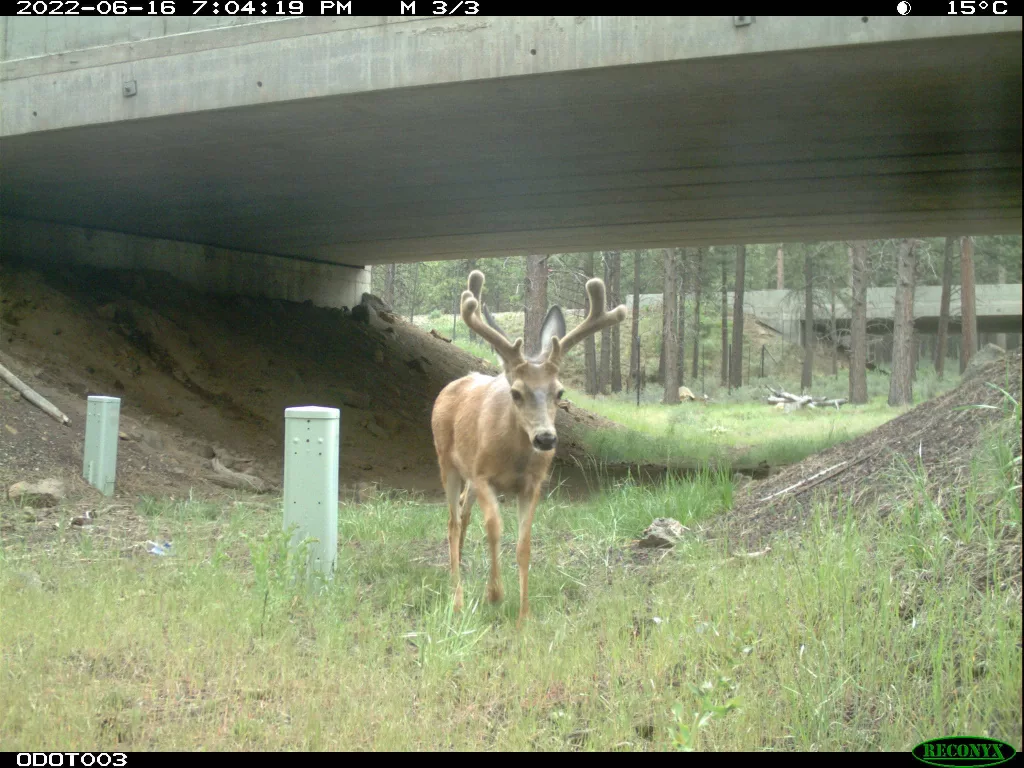Vehicle collisions with deer and elk tend to peak in October and November, when migration and breeding puts them on the move, making them more likely to cross roads. Fewer daylight hours and rainy weather also reduce drivers’ visibility.
Each year, Oregon Department of Transportation crews remove about 6,000 carcasses of deer struck and killed by vehicles on Oregon’s public roadways, and many more die away from roads or on county, city or private roads. ODFW research tracking mule deer with GPS collars shows that deer faithfully follow their migratory routes, no matter how many roads are in the way. They often have no choice but to cross roads to get to food and shelter.
Drivers should follow these tips to avoid collisions with wildlife:
- Watch for animal crossing signs: These signs mark areas with frequent wildlife crossings so stay alert when you see one.
- Be cautious in areas with dense vegetation and curves: Wildlife can be difficult to spot in these areas until they are near the road.
- Expect more animals when you see one: If you spot one animal, more are likely nearby. Focus on where the animal came from (not where it’s going), as others may be following.
- Slow down and stay in your lane: Swerving to avoid animals often leads to more serious crashes. Maintain control of your vehicle.
- Always wear your seat belt: Even minor collisions can cause serious injuries and wearing your seat belt is one of the best ways to stay safe.
This is also the time of year when the most road-killed deer and elk are salvaged for meat. Drivers who hit a deer or elk (or see one that is struck) and salvage it must fill out a free online permit and turn the head in within five days so ODFW can test for Chronic Wasting Disease. This highly infectious and always fatal disease affecting deer, elk and moose has never been detected in Oregon but was recently detected in Idaho, California, and Washington. One symptom of the disease is loss of balance/coordination, which makes road-killed deer and elk an important group to test. More info about ODFW’s Roadkill Salvage Permits can be found at https://myodfw.com/articles/roadkill-salvage-permits
Wildlife crossings are also helping reduce the number of animals on highways in some areas of Oregon. These structures create safer passage for wildlife and help protect travelers from collisions. ODFW and ODOT are continuing efforts to build more wildlife crossings to reduce wildlife-vehicle collisions and maintain long-term habitat connectivity. Key partners, including the Oregon Wildlife Foundation and the Oregon Hunters Association, have played vital roles in supporting these efforts.
If you want to support wildlife passage, consider the Watch for Wildlife Oregon license plate. Proceeds from this plate fund wildlife passage and habitat connectivity projects statewide.
You can help the state identify roadkill hotspots by participating in the Roadkills of Oregon project. ODFW, in partnership with the Oregon Zoo, is asking people for assistance recording the locations of road-killed mammals, birds, reptiles, amphibians, and invertebrates. If you see a road-killed animal of any species and it is safe to do so, pull over, take a picture of the carcass, and add it to the project on iNaturalist. These observations are invaluable in identifying priority areas for the state to take action to help save wildlife.

